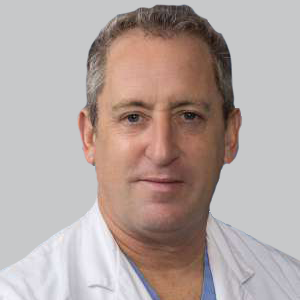News
Article
Satralizumab Shows Long-term Efficacy and Safety in AQP4-IgG-Seropositive NMOSD
Author(s):
Results from the open-label SAkuraMoon study show consistent relapse freedom in satralizumab-treated patients with aquaporin-4-IgG-seropositive NMOSD.
Jeffrey Bennett, MD, PhD

Findings from the roll-over, open-label SAkuraMoon study (NCT04660539) showed a high proportion of adult patients with aquaporin-4 immunoglobulin seropositive (AQP4-IgG+) NMOSD who remained free of relapse with a consistently low annualized relapse rate (ARR) over 4.6 years of satralizumab (Enspryng; Genentech) exposure.1 The agent, a humanized monoclonal antibody medication, was approved in 2020 by the FDA for the treatment of NMOSD.
Satralizumab-treated patients had an overall ARR of 0.09 (95% CI, 0.06-0.12). Notably, the ARR did not increase with additional years of treatment (year 1, 0.16 [95% CI, 0.09-0.27]; year 2, 0.10 [95% CI, 0.05-0.20]; year 3, 0.05 [95% CI, 0.01-0.15]; year 4, 0.07 [95% CI, 0.02-0.26]). After 4.6 years, 72% (95% CI, 62-80%) of satralizumab-treated patients were free from investigator-determined protocol-defined relapse (iPDR). At the same time, 91% (95% CI, 84-96) of patients were free from severe iPDR, and 85% (95% CI, 75-91%) had no sustained Expanded Disability Status Scale (EDSS) worsening.
These findings were presented as a poster at the annual Americas Committee for Treatment and Research in Multiple Sclerosis (ACTRIMS) Forum, held February 23-25, 2023, in San Diego, California, by lead author Jeffrey Bennett, MD, PhD, professor of neurology and ophthalmology at the University of Colorado. In this open label study, researchers assessed the long-term efficacy and safety of satralizumab in 106 adults with AQP4-IgG+ NMOSD.
Patients who completed the double-blind periods (DBPs) and open-label extensions (OLEs) of SAkuraSky (NCT02028884) and SAkuraStar (NCT02073279) were rolled over into SAkuraMoon. The patients then continued to receive satralizumab at 120 mg every 4 weeks with or without baseline immunosuppressants. Investigators analyzed all adults with AQP4-IgG+ who were at least 18 years old and received at least 1 dose of satralizumab during these studies from first dose to the cut-off on January 31, 2022—defined as the overall satralizumab treatment period.
PDRs in the DBPs were adjudicated by an independent Clinical Endpoint Committee; however, PDRs in the OLEs and SAkuraMoon were determined by the investigator. Efficacy analyses assessed the annualized iPDR rate, time to first iPDR, severe iPDR (defined as an at least 2-point increase in EDSS score), and sustained EDSS worsening (defined as an EDSS increase of at least 2, 1, or 0.5 points for patients with baseline scores of 0, 1-5, or at least 5.5, respectively, confirmed at least 24 weeks post initial worsening). Safety assessments compared the rates of adverse events (AEs) per 100 patient-years (PY) in the overall satralizumab treatment period vs the DBPs.
Overall, the median duration of satralizumab exposure was 5.0 years (range, 0.1-7.9). Rates of AEs and serious AEs in the overall satralizumab treatment period were comparable with the DBPs (AEs, 332.6 per 100 PY [95% CI, 316.7-349.1]; serious AEs: 10.5 per 100 PY [95% CI, 7.8-13.8]). Rates of infections (92.9 per 100 PY; 95% CI, 84.6-101.8) and serious infections (2.4 per 100 PY; 95% CI, 1.3-4.2) in the overall treatment period were comparable with the DBP, with no increases being observed over time. No deaths, anaphylactic reactions related to satralizumab, or injection-related reactions occurred that led to changes in study treatment.
Additional data on satralizumab previously presented at the 2022 American Academy of Neurology (AAN) annual meeting, April 2-7, in Seattle, Washington, showed that satralizumab significantly reduced the risk of protocol-defined relapse compared with placebo in the DBP of SAkuraSky and SAkuraStar.2 Satralizumab-treated patients demonstrated high rates of freedom from relapse, severe relapse, or worsening disability for at least 3.5 years in this analysis. In both studies, the mean iPDRs closest to the cut-off date were 0.21 (SD, 0.57) and 0.20 (SD, 0.64) for the respective studies and remained stable over the course of the observed period.2
Another post hoc analysis from 2021 revealed data on AEs reported as events per 100 PY from the OLE studies.3 Median treatment exposure was 205 weeks (range, 4-311) in SAkuraSky and 157 weeks (range, 5-265) in SAkuraStar during the treatment period in this analysis. Across this period, rates of AEs and serious AEs (SAEs) were comparable with that observed in the DBPs. Rates of AEs were 389.6 per 100 PY (95% CI, 365.9-414.4) and 403.0 per 100 PY (95% CI, 379.4-427.6), respectively, in the SAkuraSky and SAkuraStar studies. SAEs were also similar between the groups, with a rate of 11.2 per 100 PY (95% CI, 7.5-16.1) in SAkuraSky and 12.2 per 100 PY (95% CI, 8.4-17.1) in SAkuraStar.
Regarding its efficacy, a 2020 analysis of the 2 studies highlighted satralizumab’s impact on reduction of relapse risk, including in those with treatment-naïve NMOSD.4 In total, 1 patient who received placebo experienced a PDR on study day 21, whereas 2 of the 4 satralizumab patients experienced a relapse. The patient on placebo who experienced a PDR had a 1.5-point increase in EDSS score and was able to fully recover to prerelapse EDSS score. As for the 2 on satralizumab, the first patient experienced a PDR on day 214, with a 1-point increase in EDSS, and the second patient experienced a relapse (not meeting PDR criteria) on day 458, with a 0.5-point increase in EDSS score. Both patients were able to fully recover to prerelapse EDSS score.
Click here for more coverage of ACTRIMS 2023.




